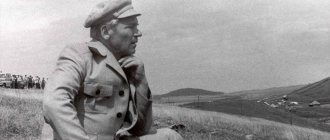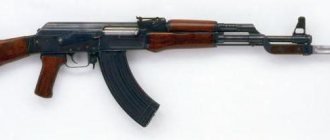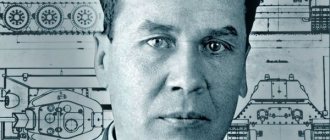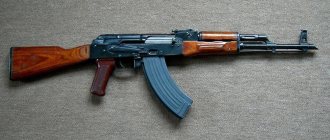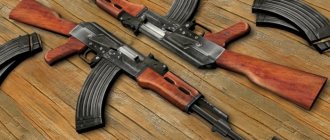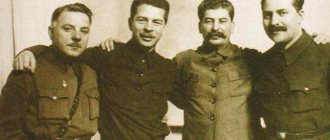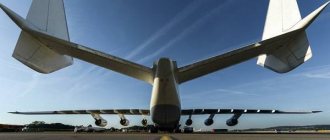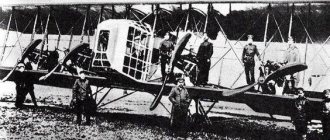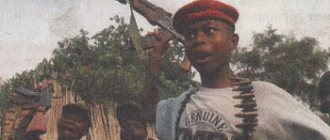- November 29, 2019
- Military
- Olga Lans
The biography of Mikhail Timofeevich Kalashnikov is the clearest illustration of the line of a popular revolutionary song: “He who was nobody will become everything.”
A guy from a large peasant family became a legendary gunsmith designer. For more than seventy years, the AK-47 assault rifle he created has been unsurpassed in reliability and ease of manufacture.
Early years
Father Timofey Alexandrovich was a peasant. He graduated from two classes of parish school and knew how to read and write. Mother, Alexandra Frolovna, was illiterate.
They lived in the small village of Kurya, Altai Territory. Of the 19 children born, only 8 survived to adulthood. On November 10, 1919, the 17th child in the family was born and was baptized by Mikhail.
In 1930, the Kalashnikov family was dispossessed and deported to a village in the Tomsk region. By the end of the year, my father died. The mother married the widower Efrem Kosach, who had three children. Here Mikhail first went to school.
Here, in the Tomsk region, he first met and became interested in small arms. Life in the new place was difficult, but there was taiga all around. My stepfather was a hunter, Mikhail learned to shoot and often went hunting. He retained this passion throughout his life, hunting even at the age of eighty.
At school, Mikhail was interested in everything: geometry, physics, and literature. He dreamed of becoming a poet. He also wanted to create various mechanisms to ease the hard work of peasants.
“I’m glad I didn’t become a poet, and without me there are plenty of bad poets”
As Mikhail Timofeevich recalled, he had a craving for invention since childhood. “My mother, apparently, gave birth to me with the makings of a future designer,” he said.
From an early age, Mikhail was constantly making something. At the age of six he tried to make wooden skates, and at the age of ten he managed to design his first pistol. True, he shot with the heads of sulfur matches. The family knew: if Misha couldn’t be heard, it meant he was busy disassembling another “thing” to understand how it worked. “It wasn’t always possible, however, to put it back together again, but if this happened,” said Mikhail Timofeevich, “I was very pleased with myself and proudly emerged from my hiding place as a winner!”
“In our village there wasn’t even a bicycle. I tried to make a bicycle - but where can I get chains and gears? Then, as a schoolboy, I decided to create a perpetual motion machine. It seemed to me that all that was missing were tiny balls. The teachers seemed competent, but I fooled their brains so much that they also began to shrug: it seemed like the engine would work if we found such a bearing,” Kalashnikov said in one interview. There was a terrible shortage of metal parts at that time, and the “perpetual motion machine” had to be abandoned.
“Then it was impossible to get a piece of wire. I wandered through the fields with only one thought - would my foot get caught on some piece of iron... When I became a deputy and traveled through rural areas, I found so many pieces of iron under every bush! And I always thought: if only I could find such wealth in Kurya! Yes, it’s not like I would have made a machine gun - the devil with horns,” Mikhail Timofeevich joked.
However, along with design and a desire for invention, poetry was also good. At school, the teacher believed that Mikhail would definitely become a poet. He began writing his first poems in the third grade, then there were friendly cartoons, lyrical messages to classmates, even plays and scripts for school holidays. Mikhail got the nickname “Poet” at school.
“Everyone asked me: “Mish, write something about love, about nature, about party leaders.” But I kept wanting to talk about metal and rhyme about engines. Although the teachers liked it. But I’m glad I didn’t become a poet, and without me there are plenty of bad poets.” As he admitted later, if not for the war, “he would have designed equipment that would make hard peasant labor easier.”
Kalashnikov made his first military inventions even before the start of the Great Patriotic War, while serving in tank forces. But only one thing was connected with small arms - a device for firing a TT pistol from a tank. The rest were more related to improvements in tank equipment, for example, a device that measured the service life of a tank engine. But the war began and tanker Mikhail Kalashnikov goes to the front. “Before the war, I really really wanted the device I created to go into series. And there was very little left until this happy moment. Yes, the sky over Leningrad split open from the explosions. And now I’m preparing to repel a new attack by the fascists,” he recalled in his memoirs.
Escape from exile
There was one obstacle to the fulfillment of desires, but it was almost insurmountable. Exiled settlers were not allowed to leave their place of residence without special permission. And it was impossible to get it.
Mikhail took a risk. Of course, the fake seal of the commandant’s office is not God knows what invention, but he escaped from the taiga wilderness. He left for Kazakhstan and got a job at the Matai station depot.
The depot was de facto a small repair shop, where Mikhail received his first skills in working with mechanisms and knowledge of their structure.
Military service
In 1938, Mikhail was drafted into the army. A short, frail guy with experience on the railway and engineering skills was sent to tank forces. He served in Western Ukraine, in the town of Stryi. He started as a driver, then became the commander of the T-50 tank.
There he first demonstrated his abilities as a designer: his first inventions were counters for cannon shots and tank service life. And an adaptation for the TT pistol, which made it easier for the crew to fire from the tank.
These inventions of Kalashnikov Mikhail Timofeevich were put into mass production.
The engine life counter was reported to Zhukov, who commanded the Kyiv Military District. Kalashnikov was called to the district, then sent to the Kiev Tank School, where prototypes were made. He traveled to Moscow with these samples for testing, then was sent to the Leningrad Tank Plant to launch the counter into mass production.
For this invention, Mikhail received his first award - a personalized wristwatch.
Front roads
Mikhail learned about the beginning of the war in Leningrad. The plant was evacuated to the East. Tanker Kalashnikov went to the front.
In October 1941, he was wounded in the battles near Bryansk, wounded, and came out of encirclement. Then there was confidence in the need for a new, compact submachine gun for tank crews. In the hospital, listening to the conversations of wounded soldiers from other branches of the military and their often extremely unflattering reviews of rifles, I realized that the entire army needed new weapons.
After the hospital, Mikhail Timofeevich received a six-month rehabilitation leave: the wound was severe, with concussion. He returned to the Matai depot and began making a new submachine gun. Precisely for manufacturing, since he thought out its design while still in the hospital.
Little is known about that first invention. It was a compact, portable weapon that was convenient to use in the cramped quarters of armored vehicles. But he had insufficient shooting accuracy. The sample required fine-tuning and was more difficult to manufacture than the Sudaev submachine gun, which was put into mass production.
Although Mikhail Kalashnikov's first submachine gun was not adopted for service, the designer's talent was noticed.
While working on the submachine gun, Mikhail Kalashnikov met Academician Blagonravov and already created his second machine gun on the basis of the evacuated Moscow Aviation Institute.
Sergeant with tablet
At the forefront of progress: what were Mikhail Kalashnikov’s tactics
The legendary AK-47 changed the concept of infantry small arms and determined the appearance of modern armies
The army opened the path to inventions for him. Kalashnikov put on his tunic in 1938. He fully corresponded to his soldier’s specialty of “tank driver mechanic”. I tried to comprehend the secret of the mechanisms, did not part with my tablet or notebooks, and constantly carried out some calculations.
Of Kalashnikov's first inventions, let's name three: an inertial counter for shots from a tank cannon, a special device for the TT pistol, which increases the efficiency of firing through the slots in the tank's turret, and also a counter for the tank's service life. The young innovator was even called to report by Army General Georgy Zhukov, and the counter became quite widespread. True, Kalashnikov was not promoted to rank, and to become a designer, he did not have enough education. And yet, for several months he finalized his implementation in the venerable Leningrad, after which he returned to the army.
From the first days of the war he fought in tank units. I experienced the bitterness of the most severe defeats in the summer of 1941. A few weeks at the front is an experience incomparable to anything else. In the battle near Bryansk, senior sergeant Kalashnikov, commander of the T-34 tank, was seriously wounded. “A booming echo hit my ears, for a moment an unusually bright light flashed in my eyes... I don’t remember how long I was unconscious... Someone tried to unbutton my overalls. His left shoulder and hand seemed alien,” that’s how he remembered that day. The village paramedic provided first aid to the wounded man. And then he spent a long time in the hospital.
Photo: RIA Novosti
Mikhail Kalashnikov while working on the AK-47 assault rifle project, 1947
In the USA, the Kalashnikov machine gun was recognized as the best weapon
There Kalashnikov set himself the task: to create a light and unpretentious automatic weapon. I got sick of this idea. The wound helped him transform from a fighter into a gunsmith. If you think about it, there is nothing incredible here: finding himself alone with himself, the young fighter was thinking about what fascinated him - about mechanics.
In Kazakhstan, while on leave due to injury, he created his first submachine gun, which, after some modifications, was sent to the Main Artillery Directorate of the USSR. “It is of no industrial interest” - this was the verdict of the experts about the weapon. But the project was not in vain: Kalashnikov was included in the Central Research Site for Small Arms and Mortar Weapons. He got a job that suited his calling.
Work at the site
Since 1942, Mikhail Kalashnikova served at the Central Small Arms Test Site, which was subordinate to the Main Artillery Directorate.
In 1944, Mikhail Timofeevich developed a gas carbine for the new 7.62x39 mm cartridge. The carbine was inferior to the new Simonov carbine and was not adopted for service. But his invention allowed Kalashnikov to take part in the assault rifle competition in 1946.
Departure
Despite many years of painstaking work, until 2012, Kalashnikov practically did not complain about his health. A sudden illness forced Mikhail Timofeevich to leave his design work. This was followed by hospitalization with a routine examination at the Republican Clinical Diagnostic Center of Udmurtia.
After some improvement in his health, in the summer of 2013, Mikhail Timofeevich was again hospitalized - this time in Moscow, where he was taken by plane from the Ministry of Emergency Situations. During examination, the designer was diagnosed with pulmonary thromboembolism. Doctors managed to tame the disease this time too. Soon Kalashnikov was back home in Izhevsk.
At the end of autumn of the same year, the creator of the legendary machine needed intensive care. The emergency operation did not produce positive results, and on December 23 the great designer passed away.
Mikhail Timofeevich Kalashnikov was buried in the Pantheon of Heroes of the Federal War Memorial Cemetery.
Assault rifle
These rifles, as a new class of small arms, appeared among the Nazis on the Eastern Front in 1943.
The rifle was very effective: it multiplied the firepower of infantry, reduced the need to use light machine guns, and in single-fire mode it hit targets at a distance of up to 200 meters. That is, it combined the rate of fire of an assault rifle and the power of a conventional rifle.
A distinctive feature was a unique cartridge: weaker than a regular rifle, but much more powerful than a pistol cartridge. It was a shortened cartridge 7.92x33 mm.
The rifle was called "Sturmgever". Soviet military leaders realized that the future belonged to such weapons.
The first Kalashnikov assault rifle
It was in this class of weapons that Kalashnikov made his first and greatest breakthrough. He designed the AK-46 for the “intermediate” 7.62*39 mm cartridge.
He presented his invention to the Ministry of Defense at an assault rifle competition in 1946. Or, in modern terms, at a tender for the selection of new main small arms for the Soviet army.
After the gas carbine, Mikhail Timofeevich did not interfere with the creation of assault rifles with an intermediate cartridge. The undisputed favorite in those years was Sudaev with his AS-44.
But the war was drawing to a close, and the army command decided not to rush into rearmament. Despite all the positive qualities, the disadvantage of the AS-44 was its impressive weight and the presence of a bipod. Such machine guns could arm 2-3 people in a squad, and the generals were not happy with this. A new competition was appointed.
Kalashnikov made changes to the design of his self-loading carbine. But by the time the competition was held, the future AK was still very far from perfect. The problem remained the same: shooting accuracy. To put it bluntly, the Kalashnikov assault rifle was an outsider in terms of shooting accuracy among all the samples submitted to the competition.
But it also had undeniable advantages: a small number of rubbing parts, ease of manufacture and assembly, a large supply of energy, which allowed the machine to grind small debris that got inside into dust. The generals, taught by the bitter experience of the recent war, appreciated the highest reliability of the weapon. And they gave the designer the opportunity to modify the machine.
So the first AK-46 became the prototype for the development of a family of experimental rifles.
Mikhail Kalashnikov: truth and myths
The tenth of November can be considered one of the memorable dates in Russian history. On this day in 1919, the outstanding Soviet and Russian small arms designer Mikhail Timofeevich Kalashnikov was born in the village of Kurya, Altai province. And on September 19 last year, under the auspices of the Russian Military Historical Society in Moscow, in the park at the intersection of Sadovaya-Karetnaya and Dolgorukovskaya streets, a monument to Mikhail Kalashnikov was unveiled.
It was Kalashnikov who developed the unique, most popular, simple and reliable assault rifle in the world. Until now, no designer has done anything like this. But Mikhail Timofeevich himself is always about. Indeed, at the moment, most armies in the world prefer the Kalashnikov assault rifle.
The Russian Military Historical Society holds the grand opening of the monument to M. T. Kalashnikov
There are many myths regarding the famous machine gun and its legendary designer. Did Kalashnikov borrow German developments? Did German engineers help him? And what other types of weapons, less known to a wide circle of readers, were invented and introduced by the famous gunsmith?
We decided to put an end to controversial issues once and for all, and for this, the correspondent of the History.RF portal met with military historian and small arms researcher Andrei Ulanov.
“We might know not the Kalashnikov assault rifle, but the Kalashnikov tanks”
– What was Mikhail Timofeevich’s youth like? Were there any interesting moments or nuances?
– Here, of course, the most significant thing that can be remembered is the fact that Kalashnikov was from a family of exiles; he could not simply leave his place of residence. Of course, it is difficult to consider the fake seal of the commandant’s office an invention, but the fact that Mikhail Timofeevich showed extraordinary ingenuity is a rather interesting fact of his biography, which he himself preferred to remain silent about for a long time, for obvious reasons. And it is necessary to further explain that the depot of the Matai station, where Kalashnikov began to work, is not a depot in the usual sense for us as just a hangar for storing steam locomotives, but in fact a small repair shop. Of course, it was difficult to become a designer there, but it was quite possible to gain a whole range of useful skills and knowledge.
– So it turns out that from an early age he began to get involved, due to the specifics of his stay, with various technical inventions?
– It’s difficult to say whether this was due to the specifics of the stay; rather, it was just a mentality or something like that. I think that he would have become a designer in almost any conditions; another question is that his activity would not necessarily be related to weapons. Actually, if not for the war, it is quite possible that we would know not the Kalashnikov assault rifle, but Kalashnikov tanks.
– Looking ahead a little, did the fact that he comes from such a family affect his life and career? Were there any problems?
– As he himself mentions, he hid this fact for a long time, but, apparently, if it became known, it did not have any impact.
– How did he come to develop weapons in principle?
– It depends on what is considered a weapon. Mikhail Timofeevich made a number of, as they say, rationalization inventions during his service in the tank forces on the eve of the war. But only one thing was connected with small arms - a device for firing a TT pistol from a tank. The rest - the inertial counter of gun shots or the engine life counter - are precisely improvements related to tank materiel.
This is described in sufficient detail in his memoirs. In the USSR, so-called rationalization activities were encouraged; for example, during the war, special brochures were even published listing which topics were most desirable. According to Mikhail Timofeevich’s recollections, they had a special notice board in their unit. Well, plus the company commander advised me to get involved and, apparently, somehow supported this endeavor.
The development of the counter was already a serious job, suffice it to say that during its testing, Kalashnikov twice met with G.K. Zhukov (who was then in command of the Kyiv Military District), received a watch as a reward and was sent to a tank factory to help put the counter into serial production production. There he met the beginning of the war. But it just so happened that the plant went to be evacuated, and tankman Kalashnikov went to the front.
– What about the device for TT?
– In general, very little is known about these inventions, and, as I already said, the main source is the memories of Kalashnikov himself, and he apparently did not consider these works important enough to describe in detail. Quite by accident, I managed to find about that very counter in one of the publications dedicated to him. But what everything else looked like is not really known.
“Even while lying in the hospital, I thought about the machine gun”
- What about the wound? And how did Kalashnikov end up in arms production?
– We can say that Kalashnikov was very lucky that he did not meet the beginning of the war in his native part. The epic of Ryabyshev’s 8th Mechanized Corps, where he served, is known quite widely, and it is not a fact that the sergeant would have been able to survive these battles. Kalashnikov was able to join his colleagues on a trip to buy new T-34s. With them, he ended up in a reserve regiment and then fought as a tank commander in the 216th separate tank regiment.
The main battles of the 216th Tank Regiment took place at the end of August 41st. The battles were difficult and, in general, unsuccessful for our units: the regiment was surrounded, and the remnants of the units had difficulty breaking out of it. There was an adventure story with Kalashnikov’s injury. He was wounded during the battle. He came out of the encirclement wounded, with his comrades; Apparently, at that moment it sunk into his soul that tankers needed a more compact version of a personal submachine gun than the PPD available at that time or later the PPSh. Already lying in the hospital, according to his memoirs, he was thinking about how to make a new type of weapon for the crews of armored vehicles; in conversations with his roommates, front-line soldiers, he only became stronger in this desire. Having completed his recovery, he received a six-month rehabilitation leave and went to the same locomotive depot at the Matai station to make his first submachine gun. You need to understand that there is no supernatural thing in the fact that some sergeant made weapons. Dozens of different samples from the rear and from the army arrived at the test site. Usually a barrel from a PPSh was taken, and on its basis samples were made, as they say, “on the knee”.
– Is this using the example of the Sudaev submachine gun (PPS), which is considered handicraft?
- Not certainly in that way. Yes, there is a stereotype about handicraft, but the mistake is that the submachine gun is not adapted for handicraft, but for mass production. It was believed that almost every artel could make it. Indeed, one of the artels was present on the list of manufacturers, but this St. Petersburg artel had extensive experience and collaborated with factories. Thus, handicraft is, rather, a stereotype caused by the confusion in the relations of the Soviet People's Commissariats. Of course, weapons cannot be made in barns; this applies more to the British “Stan”.
Almost nothing is known about the first sample of the Kalashnikov submachine gun, and its famous photo is already the second sample. Walking through the authorities, Mikhail Timofeevich meets Academician Blagonravov, who is considered the father of the Soviet school of small arms. He gives Kalashnikov his recommendation. Apparently, he saw a brilliant designer in the young man and decided to help him. The second model of the Kalashnikov submachine gun was created at the facilities of the evacuated Moscow Aviation Institute. With it he ends up at the NIPSVO shooting range (Red Army Small Arms Research Range).
– The submachine gun did not enter service, but we can already see the designer Kalashnikov, who was in search of his famous invention?
Kalashnikov submachine gun. 1942
- Right. Despite the fact that his submachine gun was somewhat similar to the Thompson - perhaps he had seen it somewhere - he continues to work on a compact weapon for armored vehicle crews, at that moment he sees just such a model as his goal. Being a tank driver, he understood all the needs of the crew members: a compact weapon required convenient placement, good firepower and, most importantly, should not restrict movement, especially in winter, when it is already difficult to squeeze into the hatches of an armored vehicle in clothes. In general, he completed this task, but due to the complexity of production and reliability, his sample required fine-tuning.
– How then did the transition to the concept of an assault rifle occur?
– It’s interesting that Kalashnikov himself has nothing to do with this. By this time, it had already been decided that the niche of a compact submachine gun was occupied by the PPS, which was already going into production. However, the military and GAU designers noted the young Kalashnikov, they liked some of his decisions and the overall originality of the design, and he went back to Central Asia to continue working on other types of weapons. He worked on a light machine gun, but the machine gun was not very successful, which, however, is typical for all models of domestic light machine guns chambered for a rifle cartridge during the Great Patriotic War, created even by eminent designers.
– Is it possible to say that by this time Kalashnikov had entered the galaxy of famous small arms designers?
- I think no. The light machine gun was produced in 1943, tested in 1944. Kalashnikov became a truly serious competitor for venerable gunsmiths a little later, during the competition for a self-loading carbine, which was won by the famous Simonov carbine. But after the machine gun, Kalashnikov was taken to NIPSVO, where he got the opportunity to get acquainted with a rich collection of small arms of all types and countries of the world, improving his skills. The opportunity to go through and study design solutions used in different types of weapons became a great help for the young designer, and there was already a real struggle with the Simonov carbine.
“The Kalashnikov sample, even in terms of the disassembly scheme and the concept of the structure, does not resemble anything else”
– How did Mikhail Timofeevich get into this competition?
– Kalashnikov initially did not get involved in working on the intermediate cartridge and the machine gun for it. The undisputed favorite at that time was the same Sudaev with his AS-44, and if not for his death, perhaps we would never have heard about the Kalashnikov assault rifle. However, there was little time left until the end of the war, and the military decided that there was no need to rush into adopting a new weapon, especially since the AS was large in weight, was called a “heavy machine gun” and had a bipod. The military was no longer satisfied that 2-3 people per squad would be armed with such machine guns, like the Germans with Sturmgewehrs, and a new competition was announced. Since Sudaev died, the competition was already held without a clear favorite, and Kalashnikov was added to the number of participants. This is the same competition in 1946 where the AK-46 appeared. Kalashnikov was among the outsiders, but got the opportunity to refine his model. Mikhail Timofeevich undertook a radical reworking of his model, and the same AK-47, now known throughout the world, was born.
– A few words about the very concept of the intermediate cartridge: how did our designers come to it?
– Judging by the documents at my disposal, our command regarded the appearance of the Sturmgever as closing a gap in the light machine gun in the Wehrmacht. The successful MG-42 was quite heavy, and the infantrymen were armed with submachine guns with a firing range of up to 200 meters. “Sturmgever” became an unpleasant surprise, which increased the density of fire of the rifle squad several times, and most importantly, delayed the opening range of fire. The command of the Red Army understood that these types of weapons were the future, and, despite the fact that the war ended with the current models of small arms, work on both the intermediate cartridge and weapons for it was already underway during the war. It is interesting that the Americans, on the contrary, regarded it as an “ersatz” weapon that the Germans made simply because they could not master a normal self-loading rifle and due to lack of funds.
– By the way, about the Americans: there is a myth that they encountered an AK in Vietnam, which became an unpleasant surprise for them, just as the Sturmgever was for us in its time...
- No, I do not think so. There is a certain amount of truth in this, but we are talking about a guerrilla war, which is not very successful for Americans as a whole. When it comes to small arms, they took a fundamentally different path, “stepping over” the intermediate cartridge. One can even say that they crushed their projects for intermediate cartridges, immediately switching to a low-pulse high-speed cartridge, which the entire NATO bloc later switched to. M-16 and other Western weapons chambered for
5.56 mm still reached the level where we were forced to catch up with them with our AK-74 chambered for the same low-pulse 5.45 mm cartridge. But, despite this, our cartridge was indeed heavier and more powerful, and due to this it did not change its flight path in the jungle, hitting the branches. Of course, the role of the AK in Vietnam is somewhat exaggerated; the partisans mostly had older models of Soviet weapons, but nevertheless, I came across reviews from veterans of the war in Afghanistan and Chechnya that it was really better to work with the green paint with a 7.62 mm AK.
- Well, the most important question. There is a misconception that Kalashnikov somehow borrowed some parts of the Sturmgever. This version still has followers. What can we answer them?
The photograph shows the fundamental difference in the disassembly scheme of the German Sturmgever and AK
– If we talk about the Soviet weapons school, we have formed our own entirely. You can even call it the school of Alexey Sudaev and NIPSVO. This is the desire for the reliability of weapons, which, starting with the PPS and moving to the AK, is achieved by a small number of rubbing surfaces and a large supply of automatic energy that grinds small debris that gets inside the weapon. This is what Kalashnikov won against Bulkin and Dementyev, the other finalists. The military decided that it was better to fine-tune the machine gun according to other parameters, but take its highest reliability as the main one. It is interesting that the Sturmgever also has borrowed components: for example, the trigger mechanism was taken from the Czech Kholek. You see, the basic designs of small arms were invented at the beginning of the twentieth century. For example, almost all pistols were invented according to Browning's scheme, and we can assume that all pistols come from him.
American rifles and carbines M-16 and M-4 are much closer in design to the German model
– Another myth is that the German Schmeisser allegedly helped Kalashnikov in his work...
- Of course not. They never crossed paths and worked in different cities. Kalashnikov made a completely original model, which, even in terms of the disassembly scheme and the concept of the weapon’s structure, is not similar to the Sturmgever. The Garand scheme used in the AK differs from the German one, and there is not an ounce of truth in the myth that one of the Germans helped him. Kalashnikov’s assistant, designer Zaitsev, and GAU officer Dementyev did a lot for the machine gun. These people need to be remembered; they really helped create the best machine gun in the world.
With your permission, I will make a small digression. The fact is that I consider Mikhail Timofeevich’s most successful invention not even a machine gun, but a machine gun, the famous PC.
Kalashnikov machine gun
This was a very big step forward, the Russian cartridge case with a rim is a big problem, it cannot be fed for stitching, but must be fed in two strokes or, as on the PC’s competitor, the Nikonov machine gun, a complex unreliable feeding system must be used. The fact that Kalashnikov made such a light, reliable and unpretentious machine gun truly became the pinnacle of his design career. But the main thing is that this is a unique machine gun (speaking of borrowings); for example, the FN MAG is much heavier and more inconvenient.
– How did the work on the new machine develop? How did it come into service and how did its evolution take place?
– Initially, the AK was, of course, a little damp. Theoretically, it could have been sent to Korea, but the result would have been as disastrous as the M-16 in Vietnam. Any new weapon requires some time to be developed and mastered by industry. Moreover, fully stamped versions became relevant already with the AKM - after all, the AK often required milling and more attention during production. Then it turned out that the Americans were working on a low-impulse cartridge, which has greater flatness, higher accuracy, and lower ammunition weight. Developing his weapon, instead of the standard RPD light machine gun, Kalashnikov developed an RPK light machine gun on the basis of an assault rifle. Despite the fact that it was a smaller machine gun than the RPD, under the new concept of nuclear war, infantry had to fire from embrasures in the sides of armored personnel carriers and infantry fighting vehicles. The new machine gun was suitable for this, and most importantly, it provided unification of cartridges for the entire squad.
– Is this where we come to the AK-74?
– It’s true that a competition began, in which Kalashnikov took part as one of the competitors, but considerations of unifying the appearance of weapons and training those called up from the reserve turned out to be decisive. The military abandoned the AK concept and adopted a new model under the symbol AK-74 chambered for a low-pulse 5.45 mm cartridge. However, we still see that many modern designs in one way or another repeat the well-known silhouette and design of the AK.
– And in conclusion, a little about the prospects of the machine gun...
– In my opinion, the possibilities for improving small arms have reached their limit. Now the main improvements are sighting devices, small improvements and improvements to small arms. I don't think anything so revolutionary could ever be invented that would be as much of a milestone in small arms as the AK.
To my regret, I personally did not know Mikhail Timofeevich, but, looking at his life, we can see his evolution as a designer. From the first samples to the hardest competition for a machine gun, where he won the competition. He also came to the PK machine gun, which became not just the pinnacle, but perhaps the best single machine gun in the world. At the same time, he worked all his life on an automatic pistol, in a competition where Stechkin won. He took part in the beginning of work on the famous Saiga hunting carbine. And in general, we see that this man devoted his entire life to his favorite business, and most importantly, as he himself said: “I invented weapons not to kill people, but to protect my Fatherland.”
Success
Kalashnikov made a number of changes and a year later introduced the AK-47. In 1949, the AK-47 was adopted as an assault rifle by the Soviet Army.
It was a high point! Judging by the biography of Mikhail Timofeevich Kalashnikov, the path to it was eleven years long - from the first adaptation to the TT pistol to the main small arms of the Soviet army. Between these two inventions there were several unsuccessful models. But every attempt gave invaluable experience and was not in vain.
Following success came recognition and awards. Mikhail Timofeevich Kalashnikov already in 1949 became a laureate of the Stalin Prize and was awarded the Order of the Red Star.
Automatic of all times and peoples
Fame came to the gunsmith. Stalin Prize 1st degree, Order of the Red Star. He moved to Izhevsk and headed the design bureau. The recent sergeant found himself at the top, which is even more difficult to stay on than to climb to it. But the genius inventor turned into a strong leader.
Photo: Kalashnikov assault rifle. Symbol of Russia/Electronic library e-libra.ru
Mikhail Kalashnikov, 1949
“Interest in our precision weapons has always been high”
Industrial director of the Armament cluster of the Rostec State Corporation - about the prospects for Russian arms exports and new developments in the domestic defense industry
The machine was produced in an atmosphere of strict secrecy, which was maintained during its operation. They even made special cases in which the soldiers were supposed to carry the miracle weapon. The Kalashnikov assault rifle was not depicted on posters in those years, and the press reported on it extremely evasively. The situation changed only in the mid-1950s.
In 1955, the AK made its debut on the big screen, in the popular feature film “Maxim Perepelitsa,” which became a kind of advertisement for army service. A year later, during the tragic events in Hungary, the machine gun fell into the hands of the Americans. It was no longer a military secret, although work on modernizing the machine gun, of course, took place behind closed doors.
It was precisely in those years that, under the leadership of Kalashnikov, a new version of the classic weapon was developed - the AKM, a modernized Kalashnikov assault rifle. The machine gun has become lighter and the sighting range has increased. This version of the machine gun received the most widespread distribution and entered service in dozens of armies around the world. It is curious that from 1947 to 1985, due to the development of technology, the cost of the machine was constantly decreasing.
After the 1950s, there was no armed conflict on earth in which the AK was not used. For many countries, the Kalashnikov assault rifle has become a symbol of the struggle for independence. It is depicted on the coats of arms of East Timor, Zimbabwe and Mozambique, and on the flag of Mozambique. This is an amazing phenomenon - both heraldic and social. It is unlikely that any weapon will become as recognizable and revered in the near future.
Photo: Getty Images/Tom Stoddart Archive
Kalashnikov assault rifles and rhino horns seized from poachers in Zimbabwe, 1989
Talking about the main work of his life, Kalashnikov liked to repeat: “The soldier created a weapon for the soldier.” This is the honest truth: he pulled the sergeant’s burden honestly and learned the truth of the trenches of war not from movies. And for a soldier on a campaign, the main thing is the simplicity and reliability of the weapon. Water, sand, and dirt are no problem for this machine. This is what they say about many types of small arms, but the reliability of the Kalashnikov has been proven by its use from tropical Africa to the harsh Arctic and has been tested over decades of service. This is its uniqueness.
AK is walking around the planet
In 1947, weapons designer Mikhail Kalashnikov created an assault rifle, which became not only the main weapon of the Soviet army, but also the national symbol of the country.
The history of the creation of the AK-47 by Mikhail Timofeevich Kalashnikov, as well as the history of the spread of the machine gun across the planet, is known to anyone interested in weapons.
The model was adopted by all countries of the former socialist bloc, and a little later by many others. Currently, modifications of the Kalashnikov assault rifle are produced in Albania, Bulgaria, Hungary, Egypt, Iran, China, Poland, Romania and North Korea, often without a license.
Very soon his brainchild gained incredible popularity on all continents, becoming a symbol of struggle. By the way, both supporters and opponents of authoritarian regimes around the world fight with Mikhail Timofeevich Kalashnikov’s weapons in their hands. Isn't this a paradox?
For reference: the armed forces of 55 countries around the world use Mikhail Timofeevich Kalashnikov’s assault rifle.
Interesting fact: the silhouette of an AK-47 can be seen on the national emblem, flag and banknotes of Mozambique. And not only this country: the machine gun is depicted on the coat of arms of Zimbabwe and Burkina Faso.
Competition of the best
Targeting the 100th anniversary: Kalashnikov’s anniversary will be celebrated in 15 regions
The head of Udmurtia invited Vladimir Putin to take part in the celebrations marking the birthday of the legendary designer
Kalashnikov dreamed of creating a weapon of victory, dreamed - as a gunsmith - to contribute to the defeat of Germany, to the capture of Berlin. Did not work out. There were many developments and proposals, but not a single one of his projects during the Great Patriotic War was implemented at the industrial level. And yet he did not give up.
In 1943, the USSR developed a new 7.62 caliber cartridge - something between a rifle and a pistol. That's what they call it - intermediate. With this cartridge it was possible to combine rate of fire and range of fire with a relatively light weapon. It is not surprising that a competition was soon announced to create a model of an assault rifle for promising ammunition. The most venerable small arms designers - Georgy Shpagin, Vasily Degtyarev, Alexey Sudaev - presented their projects to the high commission. Kalashnikov, who was little known in those years, also took part in such a representative competition.
Their work was meticulously assessed: after the great war, the bloodless country could not throw money down the drain; only the machine gun that would not become obsolete for at least 5–10 years had to enter service with the army. The fight was serious. Experts had serious complaints about all three projects that reached the finals.
Photo: commons.wikimedia.org/Mil.ru
Mikhail Kalashnikov reports to officers of the invention department of the Main Artillery Directorate of the Ministry of the Armed Forces of the USSR on the new layout of the machine gun, 1949
Private Kalashnikov
What threatens the next sale of shares of the arms concern
The Kalashnikov assault rifle was recognized as the most reliable, but, according to experts, it gave insufficient firing accuracy. In short, we had to roll up our sleeves. Front-line designer Alexander Zaitsev provided Kalashnikov with great assistance in improving the model. Together they refined the machine gun at the Kovrov plant. It was there that prototypes of the famous AK were produced.
The inventor himself also headed the production of his machine gun at the Izhevsk plant. It was a difficult and, at that time, expensive undertaking. “Kalashnikovs,” for all the ingenious simplicity of this model, are a delicate technique. For their mass production, a new level of industrial culture was required. Only a few years have passed since the war. At the same time, the nuclear project was being implemented - and then the technologists and workers were faced with a task that required new skills - starting with milling of parts.
The first batch of new machine guns was assembled by mid-1948. Military tests of the new weapon were successful, and in January of the following year the machine gun was adopted by the Soviet army.
Life after AK-47
Since 1949, Mikhail Kalashnikov lived and worked in Izhevsk, the weapons capital of the USSR. In 1971 he received the degree of Doctor of Technical Sciences and was a member of 16 Academies of Sciences.
The designer continued to work on improving and developing new weapons based on the AK-47.
In 1963, the AKM appeared. It was lighter and cheaper to manufacture by using a stamped steel receiver and contained detailed improvements such as a remolded stock and muzzle compensator.
Based on the AKM, Kalashnikov developed a squadron version of an automatic weapon, known as the RPK or PK, which used a more powerful 7.62 * 54 mm cartridge from the Mosin rifle.
The PC series is a general purpose machine gun. It is belt fed rather than magazine fed, as it is designed to provide heavy sustained fire from a tripod. Can be used as a light, bipod-mounted weapon. The common characteristics of all these weapons are simplicity of design, durability and ease of maintenance in any operating conditions.
The biography of Mikhail Timofeevich Kalashnikov states that he created about 150 models of small arms. The most famous of them are:
- AK-47.
- AKM.
- AK-74/AKS-74U/AK-74M.
- AK-101/AK-102.
- AK-103/AK-104.
- AK-105.
- AK-12.
- RPK/RPK-74.
- PC/PCM.
- Semi-automatic rifle "Saiga".
Interesting Facts
- The Kalashnikov family lived in extreme poverty. There was no money to buy school supplies. Therefore, the future gunsmith solved school assignments on birch bark.
- Mikhail Kalashnikov received his doctorate without having either a complete secondary or higher education.
- He is the author of five books, laureate of the Stalingrad literary prize in 1997. Since that time, he has been a member of the Writers' Union of the Russian Federation.
- He is the holder of the title “Legend Man” and an honorary member of educational institutions in the Russian Federation, the USA and China. All members of his family are somehow related to small arms.
Personal life
As follows from the biography, Mikhail Timofeevich Kalashnikov was married twice. The first wife was Ekaterina Danilovna Astakhova, also a native of the Altai Territory. The young people worked together at the Matai station depot. In 1942, their son Victor was born.
Later the couple separated. Ekaterina Danilovna died in 1956. Mikhail Timofeevich moved his son to his place in Izhevsk. Victor later also became a designer of small arms.
Ekaterina Viktorovna Moiseeva, the second wife, worked as a design technician. From her first marriage she had a daughter, Nelly, like Victor, born in 1942. Kalashnikov adopted the girl.
The children gave Mikhail Timofeevich Kalashnikov three grandchildren and two granddaughters. He was a happy father and grandfather.
Ekaterina Viktorovna did a lot of technical work for her husband. They had a happy marriage; in addition to their love for each other, they were united by their love for a common cause.
Gossip
In recent years, almost an exposé campaign has unfolded around the famous machine gun and its creator. Not a criticism, but a propaganda attack. Either they are trying to “overthrow” the machine gun, or the gunsmith himself - they say, he is an exaggerated figure, almost a plagiarist. This means that Kalashnikov still causes fear and envy, and, by and large, prevents the imposition of an inferiority complex on Russia. Of course, he is not alone.
Of course, Kalashnikov, like any other designer, used the already proven solutions of his predecessors. He did not create a new class of weapons and did not claim to be so. The master invented an automatic machine - super simple and effective, suitable for mass production. An assault rifle necessary for the Soviet army and in demand all over the world.
Photo: Russian Seven/russian7.ru
German weapons designer Hugo Schmeisser with an MP18 submachine gun
Kalashnikov presented a new anti-drone gun
The German small arms designer Hugo Schmeisser is sometimes called the “true author” of the unique machine gun. The name is big, the version sounds sensational, so it’s worth looking into. Herr Schmeisser, a former member of the NSDAP and creator of automatic weapons of the Third Reich, actually worked in the USSR for several years. At the end of October 1946, he was brought to Izhevsk and sent to the famous machine-building plant, which in our time bears the name of Kalashnikov. There he was registered for more than five years and in the summer of 1952 he returned to Germany - of course, to the GDR.
By that time, the health of the 67-year-old gunsmith was already experiencing serious problems, and a year later he died. It would seem that a lot of things agree: work on automatic weapons, Izhevsk. But the two inventors never worked in tandem. By the end of 1946, Kalashnikov already had a lot ready. But even in 1947, when he radically redesigned his creation, Kalashnikov had nothing to do with the Izhevsk plant. He worked on his machine gun in Kovrov, and Schmeisser wasn’t even there.
There is also an opinion: all the work was done for Kalashnikov by some high-brow, but unreliable geniuses, and the awards went to our hero only at the whim of the authorities, to whom he was convenient. But, firstly, as we know, Mikhail Timofeevich’s questionnaire was not the most ideal.
Photo: RIA Novosti/Ilya Pitalev
Mikhail Kalashnikov
And secondly, it is not clear why the “powers of this world” could have attracted the attention of him, so that they bet on him? The tank mechanic bore little resemblance to the poster ideal Soviet officer or worker; he was not known as a strong speaker and rarely spoke at meetings. And, by the way, Senior Sergeant Kalashnikov was a non-party member at that time: he joined the CPSU only in 1953, being already a recognized inventor and Stalinist laureate. So he had no trump cards other than perseverance and talent.
Of course, Kalashnikov worked in teams - no one hid this. The time of lone geniuses in the world of technology is long gone. However, this does not in any way detract from the importance of the inventor whose name the machine was given.
